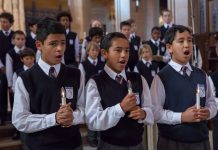
by Kate Ristow
See the end of this article for a worksheet that the children can use to write personal covenant statements.
It’s not unusual for us catechists to get tunnel vision—to become so caught up in successfully teaching each individual chapter in our texts that students are not able to see the forest for the trees. In other words, we are not always as effective as we could be in helping kids see the big picture—God’s plan for all people—and the relationship between each lesson and God’s plan.
For example, we may be so determined that students learn to recite the Ten Commandments by heart that we fail to emphasize how these laws ready us for the happiness of eternal life. Or, in a lesson on sin, we might emphasize the distinctions of original, mortal, and venial sin but only briefly touch on God’s love and how God’s love is greater than the power of evil—this is why we can believe in all of God’s promises to us. Through Jesus, God makes it possible for us to turn away from sin and to choose a life of love. This is especially important for children to recognize as they prepare to celebrate Jesus’ Resurrection on Easter.
We are called to help children recognize—without sugar-coating the truths of our faith—that living as disciples of Jesus and children of God is an attainable goal. Our mission as catechists is to communicate our story with joy and hope. We want students to understand God’s plan for all people and how our Catholic doctrines and traditions relate to the fulfillment of this loving plan.
What Is God’s Plan?
God’s plan is for every human person to live in friendship with him during his or her earthly life and in eternal life in heaven. The Catechism of the Catholic Church teaches: “We can…hope in the glory of heaven promised by God to those who love him and do his will. In every circumstance, each one of us should hope, with the grace of God, to persevere ‘to the end’ and to obtain the joy of heaven, as God’s eternal reward for the good works accomplished with the grace of Christ” (n. 1821).
God loves us so much that he invites us to share everlasting life and unending happiness in his kingdom. When our earthly lives are over, we will be judged on how well we have demonstrated our love for God, ourselves, and others. Through the gift of free will, God gives us the ability to make good decisions to live as his children.
In a sense, the choices we make in life determine the judgment we receive from our compassionate and merciful God. If we have tried to live according to the teachings and example of Jesus, God will welcome us into the Kingdom of Heaven.
God Helps Us to Follow Him
God gives us constant help and support so that we might live holy lives. Use the following activities to explore these signs of God’s love with your class. Help your students see that, through each one, God invites us to everlasting life.
Jesus
* Jesus is the Good News. The Catechism teaches: “The Paschal Mystery of Christ’s cross and Resurrection stands at the center of the Good News…God’s saving plan was accomplished ‘once for all’ by the redemptive death of his Son Jesus Christ” (n. 571). Explain that God most fully reveals himself to us in Jesus and that we grow in holiness by following the example and teachings of Jesus. Invite volunteers to recall and summarize a Scripture story in which Jesus teaches us something about God. Allow children to use their texts or Bibles for this activity.
* Remind children that Jesus is God’s only Son. Discuss how the Incarnation—God’s Son becoming truly human while remaining truly divine—shows God’s love for us.
* Help students recall that Jesus died to atone for our sins and that he rose so that we might share in his new life. Remind students that we will soon enter into the holiest week of the year, and then divide the class into three groups. Assign one of the celebrations of the Triduum (Holy Thursday, Good Friday, or the Easter Vigil/Easter Sunday) to each group and have groups design posters that show how these liturgies celebrate Jesus’ Paschal Mystery, the heart of God’s loving plan for us.
Creation
* Tell students that God also helps us know and love him through Creation. Read and discuss the First Story of Creation (Genesis 1:1-31). Help children appreciate that God created the world out of nothing but goodness and love. Ask how God showed his special love for people. Emphasize that because human beings are made in his image and likeness, God made people the crowning act of Creation.
* Have students name what God reveals about himself through different aspects of nature. For example, the sun might be a sign of God’s never-ending presence; mountains might be a sign of God’s power and majesty; etc.
* Invite older students to do a choral reading of Isaiah 43:1-7 to reinforce God’s never-ending love. Work together to create a list of different things the children can do to show respect and care for God’s creation.
Sacred Tradition
* Have older students work in pairs to create three-column charts that list Catholic beliefs, how we worship, and specific ways in which we live our faith. Recall the covenants God made with the Israelites and that, in Jesus, a New Covenant was established. Help the children appreciate that when we follow the teachings of the Church, celebrate together at liturgy, and live as God calls us to live, we keep our part of the covenant and cooperate with God’s plan of salvation. Point out that through God’s merciful love, those who keep the New Covenant established in Jesus will be rewarded with eternal happiness in the Kingdom of God.
* Direct students to turn to the prayer section in their texts and locate the Nicene Creed and the Apostles’ Creed. Note that creeds are summaries of Catholic beliefs that developed over time. Working in groups, have students create creeds—using their own words—that state our beliefs in God, Jesus, the Holy Spirit, the Church, and life everlasting. Invite a volunteer from each group to read aloud their completed creed.
The Holy Spirit
* Remind students that at the Last Supper, Jesus promised to send the Holy Spirit to be with us always. Have students use Bibles to read “The Coming of the Spirit” (Acts of the Apostles 2:1-4). Emphasize that the Holy Spirit is our helper and guide.
* Have students work in small groups to create skits demonstrating individuals their age cooperating with the Holy Spirit’s presence. Allow time for each group to perform its skit.
* Have a volunteer define the word conscience (our ability to know and judge what is right and wrong). Point out that our conscience guides us in living as God’s children. Explain that we must find time to listen prayerfully for the Holy Spirit to speak to us in the silence of our hearts. Impress upon the children that the formation of the conscience and the practice of prayerful listening both take time to develop. Set aside class time to help students practice these skills. Start with one moment of silence and gradually build up to five minutes.
The Church
* Recall that after the Resurrection, before Jesus ascended to his Father, he gave his Apostles the mission of making disciples of all nations. The coming of the Holy Spirit enabled the Apostles to share Jesus’ Good News. As a result, the Church flourished in all parts of the world. Invite volunteers to name ways that children their age can share the Good News. Help everyone appreciate that our loving and caring actions often speak louder than our words.
* Help students list on the board the names we use to describe the Church, such as the Body of Christ, the People of God, the Temple of the Holy Spirit, a Light to the World, the Communion of Saints, and so forth. Talk with students about how these descriptions encourage us to live holy lives.
Our Moral Teachings
* The Ten Commandments, the Beatitudes, the Two Great Commandments, the New Commandment, and the Corporal and Spiritual Works of Mercy teach us how we are called to live. Review these teachings over the course of several weeks—not all at once.
* Have students work in groups to make charts showing how they can live each of the Ten Commandments. This activity will require time. It’s worth it! It personalizes the Commandments for the kids and helps them see practical ways of putting them into practice. Ask volunteers to share their group’s work with the class. Affirm the children for thinking of concrete ways to live God’s laws.
* Create a bulletin board or poster that allows students to see the fruits of living the Church’s moral teachings. Prepare small hearts on which the children write how they have kept one or more of the Church’s moral teachings during the week. Then have students affix their hearts to the bulletin board or poster, or have them make a chain by stapling the hearts together side-by-side. Take time in each session to invite students to share how they have shown their love for God, others, and themselves. Make the connection between living our moral teachings and preparing for everlasting life in heaven.
Prayer and Scripture
*Saint Paul urges us to “pray without ceasing” (1 Thessalonians 5:17). Note that the more we pray, the closer we grow to the Lord and the better we understand God’s plan and direction in our lives.
*Have students keep a prayer log during the remaining days of the Lenten season and Holy Week, noting how often and when they pray, how they pray, and their thoughts about prayer. Allow a few minutes during each class for students to share their observations about how their prayer life is growing or deepening through this activity.
*Encourage older students to read the Bible daily. Suggest that they choose one of the Synoptic Gospels to read first. As their daily evening prayer, they might want to read a psalm. Explain that reading the Bible helps us see how God revealed his plan through Sacred Scripture.
These are just a few of the many ways the Lord reaches out to help us share in the happiness of heaven. Impress upon your students how very fortunate we are to be God’s adopted sons and daughters! Truly, God has paved the path for us. Invite the children to respond to God’s love by living in his light.
Frequent Reception of the Sacraments
The Seven Sacraments make us sharers in the saving work of Jesus and the life of the Holy Trinity. Remind students that we receive the gift of sanctifying grace when we celebrate the Sacraments. Explain that this grace helps us grow in holiness and participate in God’s loving plan of salvation.
Discuss with students how receiving Eucharist on a regular basis helps us respond to God’s plan. Help students understand that receiving the Body and Blood of Christ strengthens us in our faith and helps us love and serve others, as Jesus did.
Talk about the positive effects of celebrating the Sacrament of Penance and Reconciliation. Point out that through this Sacrament, we are freed from sin and grow closer to the Lord. We also grow in our understanding of how important it is to forgive others as God forgives us.
Read aloud “Treasure in Heaven” (Matthew 6:19-21). Discuss how celebrating the Sacraments of Reconciliation and the Eucharist helps us “store up treasures in heaven.” Incorporate this Scripture passage into your closing prayer.
Personal Covenant Statements
Use this worksheet [CLICK HERE] to help students create their own personal covenant scrolls, listing what they will do to live holy lives in preparation for eternal life in heaven. Before having the children work independently, discuss possible statements they might include in their covenants. Be sure to have them sign and date their covenant statements.
When students finish writing, have them roll their scrolls and tie them loosely with pieces of yarn. Place the scrolls on the classroom prayer table. After the closing prayer, have children collect their scrolls and take them home as reminders of God’s love for them and their promises to God.
Copyright 2012, Bayard, Inc. All rights reserved. This article is protected by United States copyright and other intellectual property laws and may not be reproduced, rewritten, distributed, redisseminated, transmitted, displayed, published or broadcast, directly or indirectly, in any medium without the prior written permission of Bayard, Inc.
This article was written by the Catechist Staff and appeared in Catechist magazine, February 2012.
Image Credit: Shutter Stock 401699041




